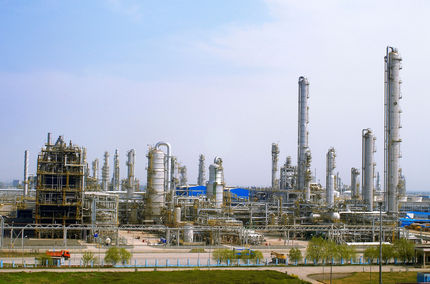BASF and SINOPEC submit feasibility study for $900 million expansion of Nanjing site
New activities to come on stream stepwise starting in 2008, cracker expansion planned for 2009/2010
BASF and China Petroleum & Chemical Corporation (Sinopec Corp.) submitted the technical and commercial feasibility study for the approval of the planned $900 million expansion of their joint chemical Verbund site in Nanjing to the Chinese government. The site is operated by the joint venture BASF-YPC Co. Ltd. (BYC).
The completion of the study was formalized by Wang Tianpu, President of China Petrochemical Corporation (Sinopec Group) and Dr. Martin Brudermüller, member of the Board of Executive Directors of BASF SE, at a signing ceremony in Beijing.
The main pillars of the expansion are:
- Expansion of the steam cracker from 600,000 to around 750,000 metric tons of ethylene per year.
- Expansion of the ethylene oxide (EO) plant and development of EO derivatives to strengthen the ethylene value chain by producing non-ionic surfactants for detergents and the solvent butylglycol ether. New projects regarding production of amines for surfactants and dimethylamine (DMA-3) for flocculants.
- Development of the C4 value chain including C4 specialties: Butadiene and isobutene as chemical raw materials, 2-propylheptanol for a new-generation plasticizer and polyisobutene derivatives as fuel and lubricant additives.
- Extension of the acrylics value chain to produce superabsorbent polymers (SAP) for hygiene and industrial applications.
- Expansion of the existing oxo-alcohol and propionic acid plants.
The new activities are expected to come on stream stepwise starting already this year; the cracker expansion is scheduled for 2009/2010.
Most read news
Other news from the department manufacturing
These products might interest you

Eclipse by Wyatt Technology
FFF-MALS system for separation and characterization of macromolecules and nanoparticles
The latest and most innovative FFF system designed for highest usability, robustness and data quality

Spinsolve Benchtop NMR by Magritek
Spinsolve Benchtop NMR
Spinsolve is a revolutionary multinuclear NMR spectrometer that provides the best performance

HYPERION II by Bruker
FT-IR and IR laser imaging (QCL) microscope for research and development
Analyze macroscopic samples with microscopic resolution (5 µm) in seconds

Get the chemical industry in your inbox
By submitting this form you agree that LUMITOS AG will send you the newsletter(s) selected above by email. Your data will not be passed on to third parties. Your data will be stored and processed in accordance with our data protection regulations. LUMITOS may contact you by email for the purpose of advertising or market and opinion surveys. You can revoke your consent at any time without giving reasons to LUMITOS AG, Ernst-Augustin-Str. 2, 12489 Berlin, Germany or by e-mail at revoke@lumitos.com with effect for the future. In addition, each email contains a link to unsubscribe from the corresponding newsletter.




























































